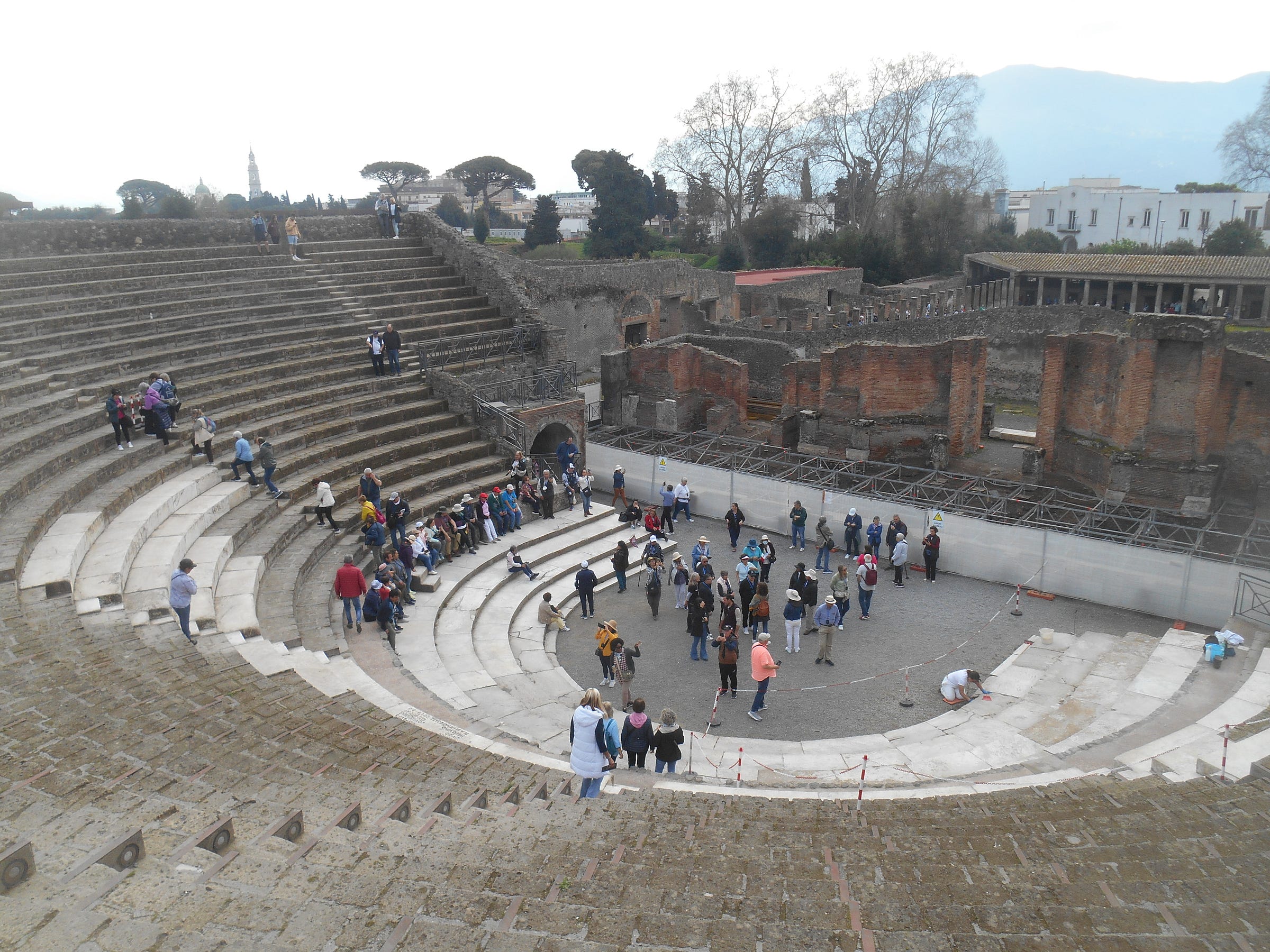
For both archeologists and historians in academia, along with countless enthusiasts worldwide, the rise and fall of the Roman Empire remains a topic of intense fascination and study. Even after the fall of its western half in 476 AD, followed by the collapse of its eastern half centuries later in 1453, the fact that its imprint still exists throughout Europe, the Middle East, and the northern shores of Africa in terms of its ruins and historical artifacts means that the legacy of the Roman Empire remains as relevant as ever for today.
Considering that the Roman Empire began in 27 BC following its origin as the Roman Republic in 509 BC, its geographical reach during its high point close to 2000 years ago remains a staggering historical accomplishment whose impact in terms of architecture, engineering, language, culture, art, literature, judicial practice, urban development, and so on reverberates constantly in our daily lives—often without our even realizing it. When at its peak in 117 AD, the Roman Empire stretched all the way from Portugal and Spain in the west to the Arabian Peninsula and Persia in the east, while it reached as far south as the interior of Egypt and as far north as the southern part of Scotland where the Antonine Wall was built by Roman soldiers in 144 AD, named after Emperor Antoninus Pius. It was quickly abandoned by the Romans in favour of fortifying the more significant Hadrian’s Wall named after Emperor Hadrian, constructed around twenty years earlier to span the entire width of northern England and define the northern border of the Roman Empire for centuries thereafter.
From a modern-day traveller’s perspective with the advantages of commercial aircraft to cover long distances in a matter of hours, it’s easy to forget how the Roman Empire managed to grow as large as it had during its prime and sustain itself over centuries with only boats and foot traffic to navigate its perimeter and interior. For a Roman soldier, regular citizen, or slave living in Rome or southern Italy to work on a farm or perform some menial work, the idea that the Roman Empire could reach as far north as modern-day Newcastle where the remains of Hadrian’s Wall still exist today must have been beyond their wildest imaginations. From their vantage points, the Roman province of Britannia may as well have been on another planet entirely.
I learned while living in Lancaster in northwest England over 20 years ago that it was originally known as Luncastrium, a Roman settlement originally named after the moon in Latin. More recently, my historian friend Dan told me that all modern-day British cities and towns with the “chester” suffix in their names, such as Colchester, Dorchester, and Rochester were originally Roman settlements because the suffix refers explicitly to “Roman camp.” A first failed attempt at invasion of England by boat was made by Julius Caesar in 55 BC, after which almost a hundred years later Britannia was finally conquered by Emperor Claudius in 43 AD. London was then known as the Roman settlement of Londinium when founded by the Romans in 47-50 AD, which served as a major port and commercial centre until it was eventually abandoned in the 5th century AD with the overall decline of the Western Roman Empire. The fact that countless numbers of archeological discoveries throughout the United Kingdom continue to emerge with time is a testament to the deep significance that the Roman Empire had on the ancestors of modern-day Britain.
Having visited both Italy and the United Kingdom countless times over the years, I’ve had the opportunity to see for myself the legacy of the Roman Empire on multiple occasions. So when I decided to travel to Newcastle in February 2024, followed by a trip to southern Italy near Naples to attend a physics conference one month later, I saw an opportunity to revisit the Roman city of Pompeii and visit for the first time Mount Vesuvius, the volcano that erupted in 79 AD and was responsible for destroying Pompeii and surrounding areas with volcanic ash, while simultaneously preserving it for future excavation by archeologists. As a UNESCO World Heritage site, Pompeii is regarded as one of Italy’s most popular tourist attractions, with roughly 2.5 million visitors each year to gain the awareness of what life was like in a typical Roman city. At least for me, it was definitely an incredible experience that I won’t soon forget.
Hadrian’s Wall and the Segedunum in Newcastle
When I first visited Newcastle at the tail-end of winter with cold breezes that come off from the North Sea, I could only imagine what it must have felt like for Roman soldiers, citizens, and slaves to live and work in this region of Britannia throughout the year, and ultimately build Hadrian’s Wall in 122 AD. While much of its ruins today are a mere shadow of how it must have appeared when it was finally completed by Roman soldiers to keep out invaders on the northern side, the best known information about Hadrian’s Wall is that it represents a very sophisticated feat of engineering that took into account the formation of nearby settlements, military forts, and other aspects of Roman civilization to preserve the integrity of this border wall. Throughout the counties of Northumberland and Cumbria, and also within the city of Newcastle, there are bits and pieces of Hadrian’s Wall still standing, which I happened to see while passing by on the road.
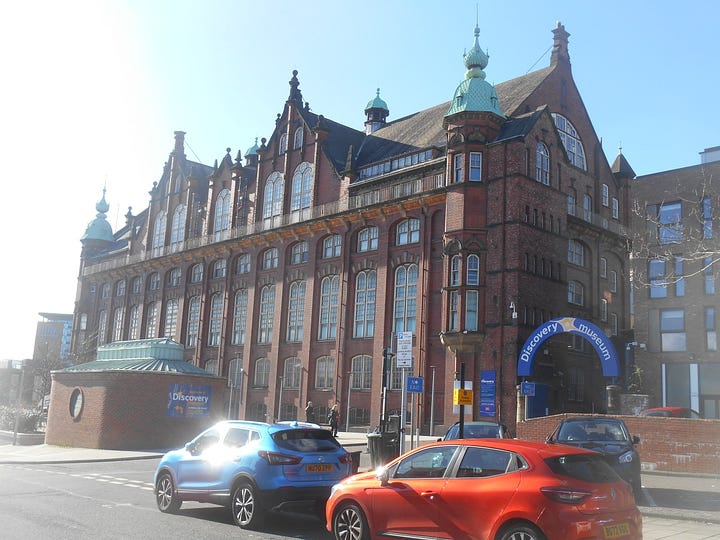
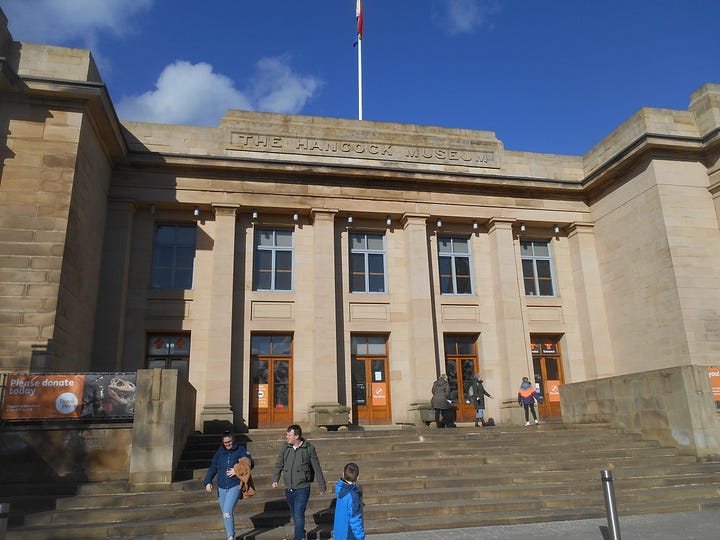
I learned later that Hadrian’s Wall was both regarded as a defensive structure and a strong political statement about the Roman Empire’s prowess and strength to keep out invaders from entering Roman civilization. Scholars claim that Hadrian’s Wall was 73 miles (117 km) long, that it was 8 to 10 feet (2.4 to 3.0 metres) wide, and at least 12 feet (3.7 metres) high. The wall was manned with Roman soldiers with a watch tower and fort built every one-third mile, the latter of which housed 600 men apiece. It’s uncertain whether there was a walkway on the top of Hadrian’s Wall for soldiers to navigate and monitor the northern border. However, there’s increasing archeological evidence that numerous settlements were built nearby Hadrian’s Wall to provide significant resource support over the centuries prior to the fall of Rome. In 2003, an 84 mile (135 km) long footpath called Hadrian’s Wall Path was created to track the length of Hadrian’s Wall, and is open to the public during the summer months.
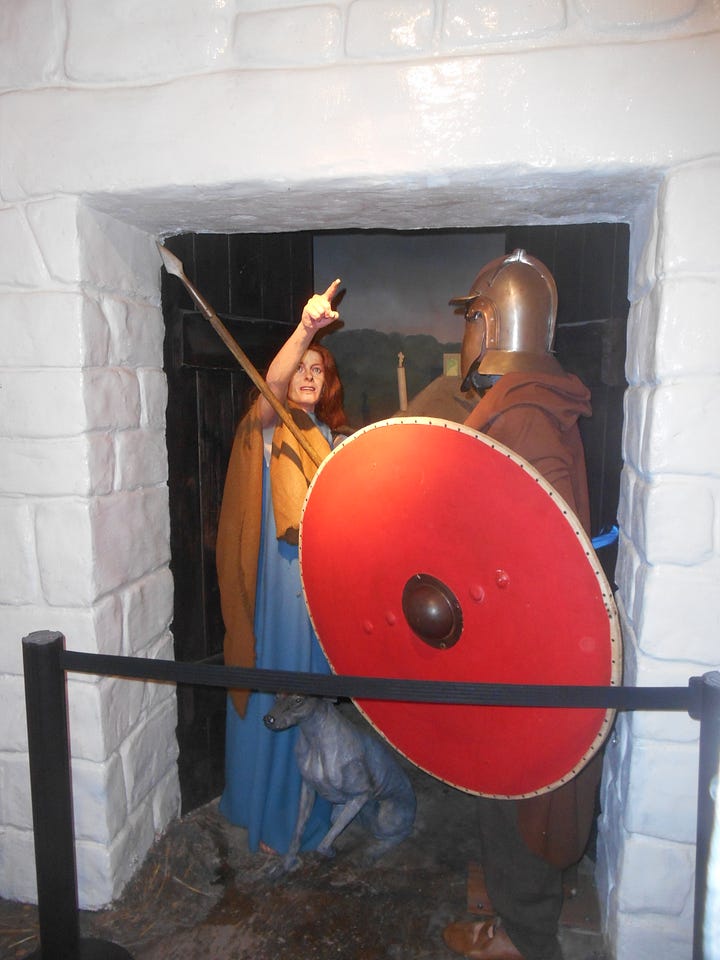
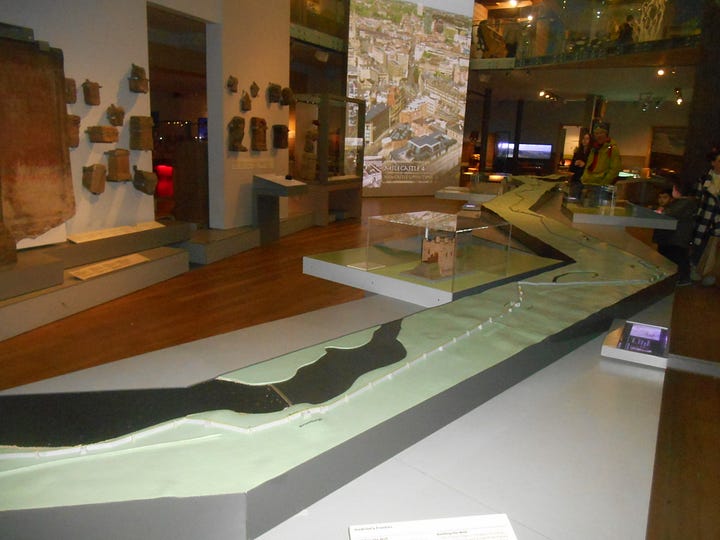
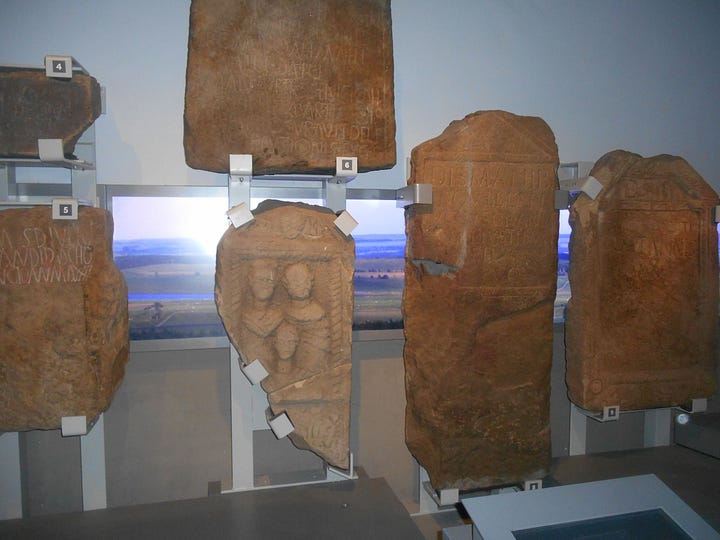
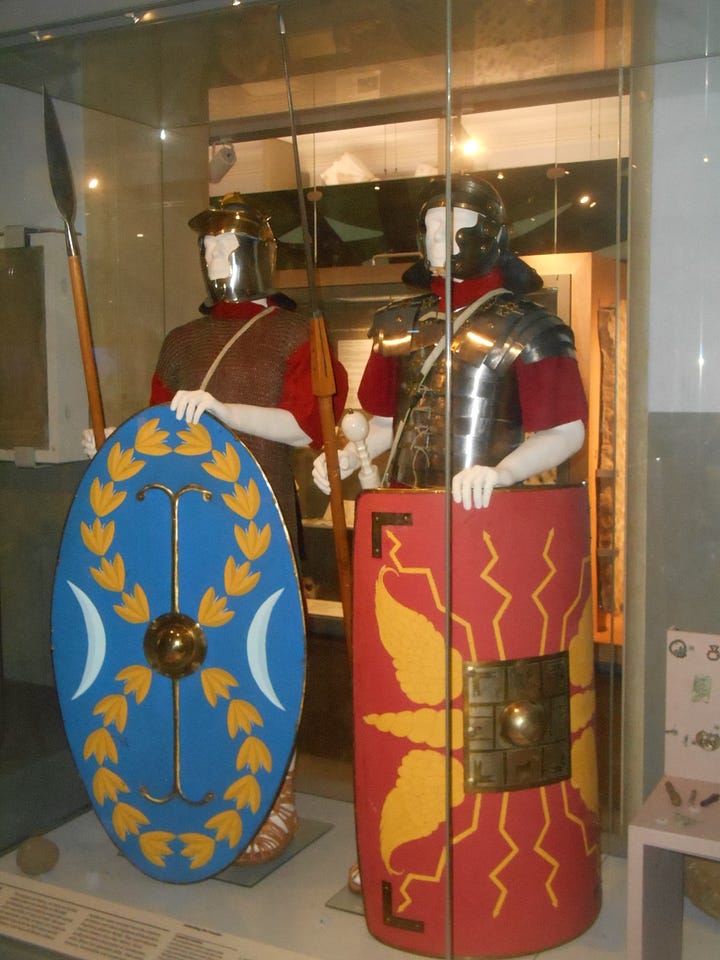
To get a better sense of overall Roman history in Newcastle, I first went to Discovery Museum located at Blandford Square, Newcastle-Upon-Tyne NE1 4JA (https://discoverymuseum.org.uk/), followed by The Great North Museum: Hancock (more commonly known as Hancock Museum) located at Barras Bridge, Newcastle-Upon-Tyne NE2 4PT (https://greatnorthmuseum.org.uk/). Both museums have a variety of exhibits that cover the history of Newcastle from the Roman era onwards, along with some prehistoric natural history in the latter. Besides showing a collection of stone artifacts and Roman soldier gear, Hancock Museum also has a large model display of the section of northern England where Hadrian’s Wall appears, starting from the nearby town of Wallsend in the northeast to Bowness-on-Solway, a village in Cumbria near the northwest coast of England.
Later that day, I went to visit Segedunum Roman Fort and Museum on Buddle Street, Wallsend NE28 6HR (https://segedunumromanfort.org.uk/) that represents the easternmost part of Hadrian’s Wall with the remains of a 2000 year-old Roman fort called Segedunum, which literally means “strong fort.” To greet visitors to the museum, there is a larger-than-life steel sculpture of Roman centurion (8.5 feet or 2.8 metres) with the name “Sentius Tectonicus” on display outside of the main entrance and was created by local artist John O’Rourke (https://www.johnorourkeart.com/). The museum is open daily from 10:00 am to 5:00 pm, with the outdoor section closed at 4:30 pm.
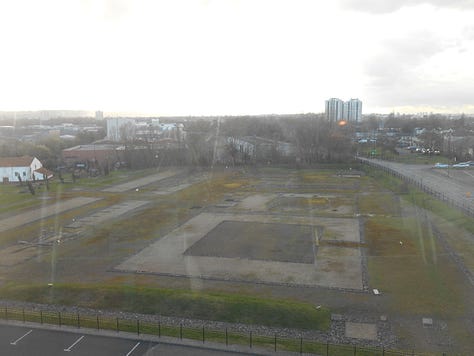

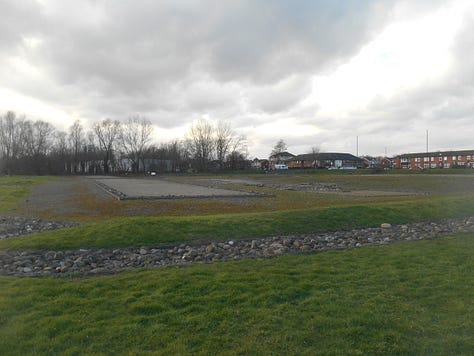
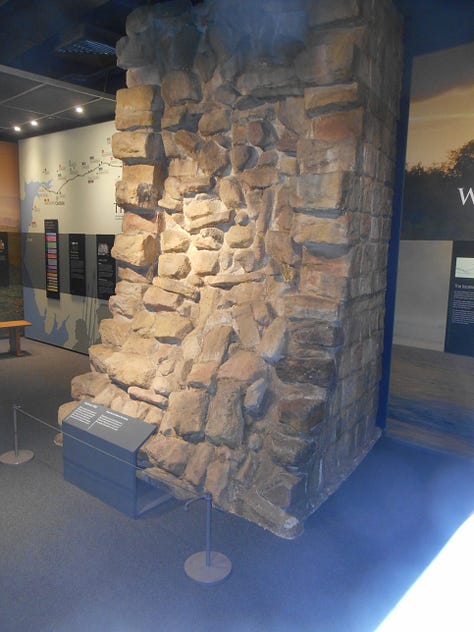
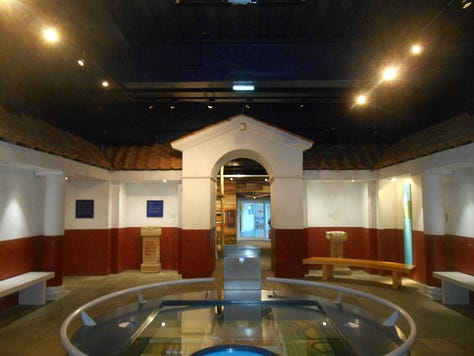
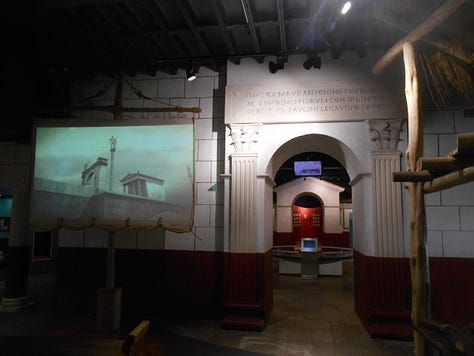
While people are free to walk among the ruins of Segedunum to get a sense of scale for its size, they are also able to see it from above by going to the 9th floor observation tower to gain a panoramic view of the fort and surrounding landscape while facing westward along the direction of Hadrian’s Wall located just north of the Tyne River. Inside the museum on the main floor is an extensive recreation of the full height of Hadrian’s Wall and the fort’s interior, which also showcases some archeological findings onsite. There is a small film theatre to showcase vignettes of actors role-playing the lives of all people from Roman soldiers to slaves who would typically work and live at Segedunum. The museum also has bookable rooms available for conferences and large public functions that can be hosted there.
The Temple of Mithras in Central London
On September 18, 1954, just a few years after the end of World War II, a major archeological discovery was made in central London. Following a scheduled archeological expedition during the reconstruction of the city, there appeared the remnants of a 240 AD Roman structure in the heart of Londinium. It was later determined that the archeologists uncovered a temple dedicated to the Roman god Mithras, whose origins as a belief system came all the way from Persia. This was a monumental finding at the time to reveal another rich thread of Roman life in Britannia, and yet not many people in London even know that they can see it for themselves! In fact, it’s so obscure from direct view that most Londoners who need to use Bank Underground Station on a daily basis are all-too-quick to pass by its entrance immediately on the left, not realizing the presence of something very special to view and appreciate.
Located inside and underneath the Bloomberg European Headquarters Building at 12 Walbrook EC4N 8AA (https://www.londonmithraeum.com/), London Mithraeum Bloomberg SPACE is a unique museum experience that not only showcases the temple of Mithras in virtually its original form when first discovered, it also provides the visitor with an immersive multimedia expression of what a gathering of Mithras followers would likely experience during a ritual visit. It’s open from Tuesday to Saturday from 10:00 am to 6:00 pm, Sunday from 12:00 pm to 5:00 pm, and 12:30 pm to 6:00 pm on Wednesdays during term time for school.
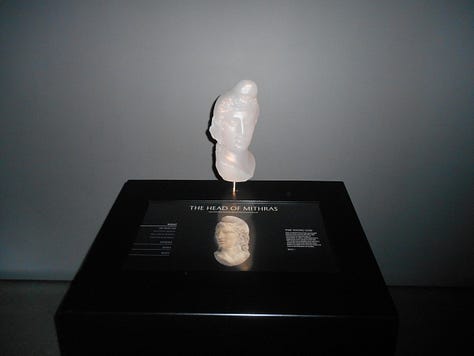
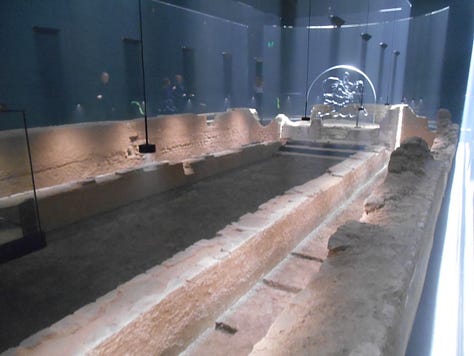
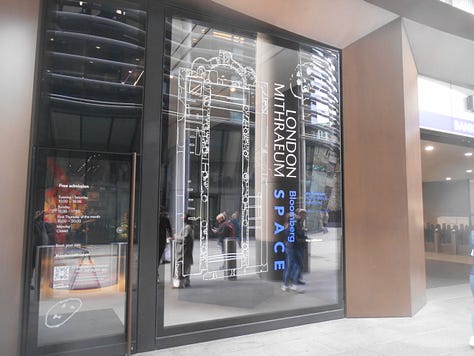
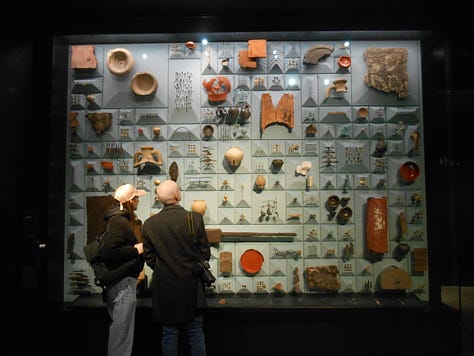
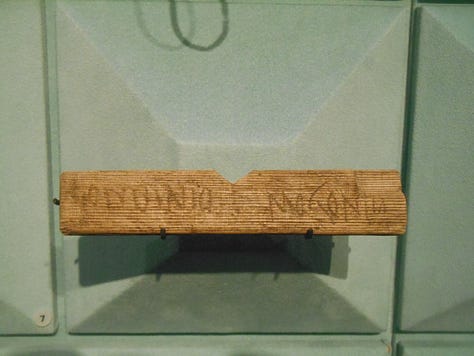
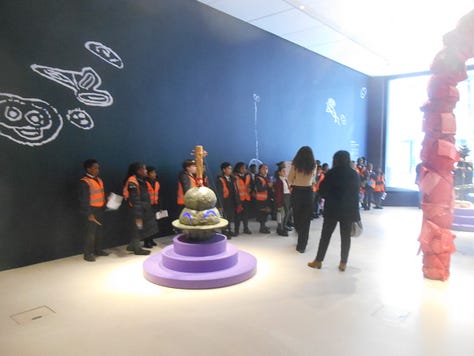
According to the best available evidence, the Mithraeum was in continuous use until the 5th century AD when it was abandoned to the elements alongside that of Londinium during the decline of the Western Roman Empire. The ruins eventually became buried underneath with layers of soil and remained preserved for centuries until it was finally discovered in an area that was heavily bombed by the Nazis during the London Blitz. Following its discovery, the news attracted major interest from the public, with as many as 30,000 people waiting in line one day to view the excavation. The Mithraeum was later dismantled and relocated nearby its original location in 1962. When Bloomberg committed to the construction of its European Headquarters Building in December 2010, the decision was made to restore the Mithraeum to its original location at street level during the Roman era, plus create two new public spaces to feature specially commissioned art displays, along with a retail arcade that follows a known Roman travel route.
About a month after visiting Newcastle and Hadrian’s Wall, I committed myself to visit the Mithraeum. Upon entry into the main space just before going to the exhibit located downstairs, I found myself viewing a large wall display with a number of Roman artifacts of various kinds discovered onsite during recent excavations. One of the most profound among them is the oldest known sample of Roman-era writing to be found in the United Kingdom. As well, I saw in the main space a contemporary art display that Bloomberg has made open for commissioned pieces to appear.
Entry into the Mithraeum requires going down a flight of stairs to a mid-level space that has on display select artifacts pertaining to Mithras, with an electronic database of historical information to accompany them. This space also serves as a waiting area for visitors to gather before a restricted number are permitted go down another flight of stairs to where the Temple of Mithras is presented to the public and the multimedia experience to eventually begin, filled with soft lighting and mist present throughout the space and the piped sound of ritualistic chanting from actors portraying the followers of Mithras.
I was about to finish my visit at the Mithraeum when a group of young school children showed up with their teachers on a pre-scheduled field trip. It was interesting for me to see them engaging in their lessons about the Roman Empire and its significance as a major historical influence in London where they currently live. While it remains to be seen how much of an impact the Mithraeum will have on the future of these young students who happened to show up when I there, what I know for certain is that my own recent visit made a huge impression upon me.
Pompeii and Mount Vesuvius Near Naples, Italy
On the morning after visiting the Mithraeum in London, I boarded a flight to southern Italy and eventually arrived in Naples for a weekend visit. While there the next day, I took the opportunity to pay my second visit to Pompeii and also for the first time scale Mount Vesuvius as part of an overall day trip organized by World Tours Italy (https://www.worldtoursitaly.com/), which offers a multitude of tourist packages for visitors to see southern Italy from Naples and Pompeii in the north to the Amalfi Coast and Sorrento located further south.
For this tour, I joined a random group of roughly 20 people coming from Europe and other parts of the world to take in a two-hour walking tour of Pompeii, followed by an excursion to hike up to the summit of Mount Vesuvius, after which we spent our remaining time at a local winery and vineyard to partake of wine-tasting for those who consume alcohol, plus have a three-course meal in its dining room.
While waiting at my designated meeting area across from the Naples train station, there were several people also standing by to await any number of busses organized by World Tours Italy to appear. Despite the perpetual chaos of traffic that naturally congregates in that area, I managed to see a number of its busses show up on time, including the one that would take me to Pompeii. Eventually, I found our tour guide, a very likeable and enthusiastic young woman named Alessandra who identified herself to us waiting to board. After giving us each a wrist band with her phone number in case of emergency, we entered the bus operated by her work partner Bruno and then immediately began the drive south of Naples towards Pompeii.

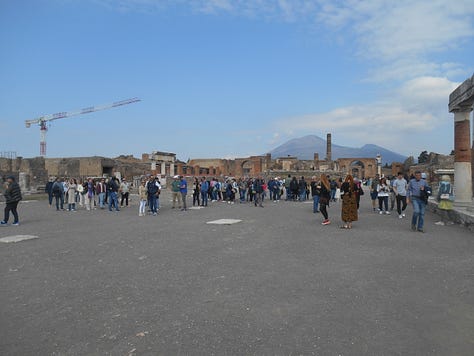
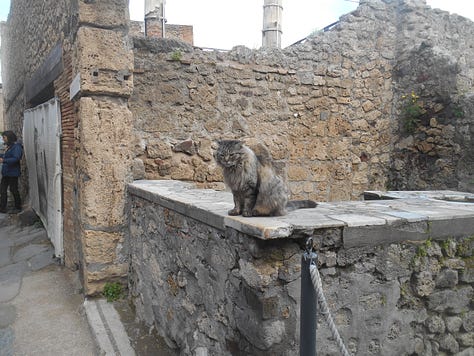
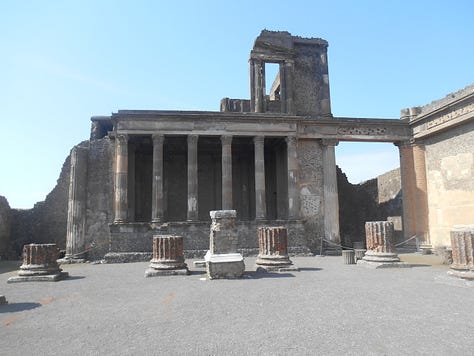
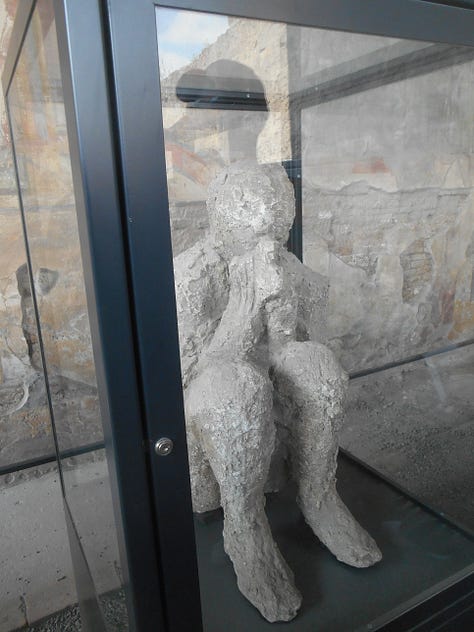
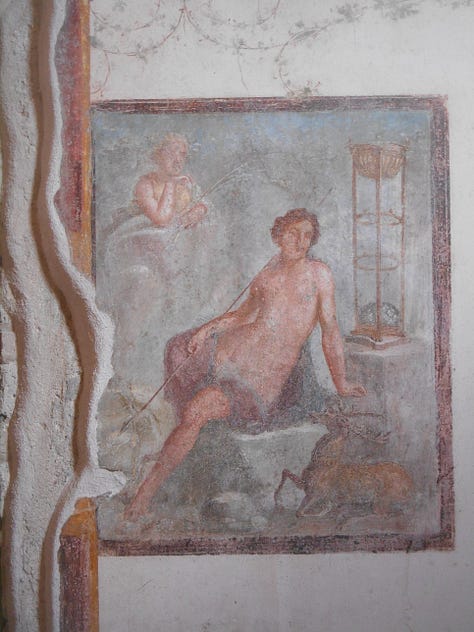
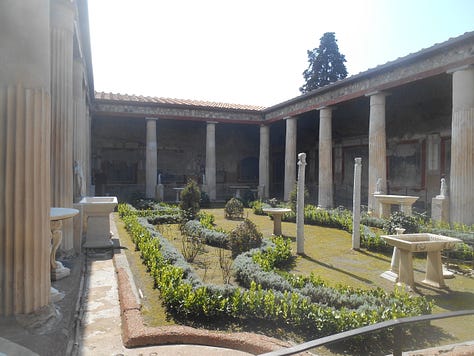
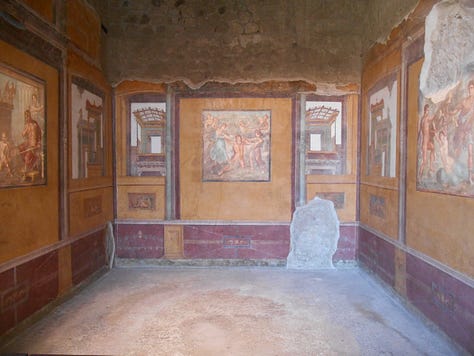
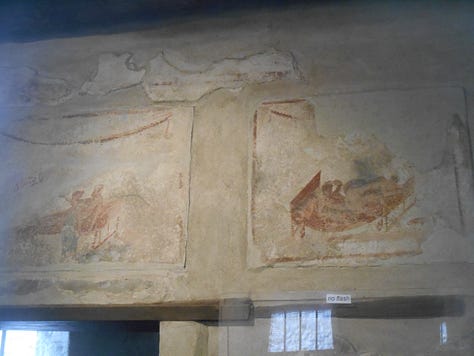
About 15 to 20 minutes after leaving Naples, we arrived at a bus park beside Pompeii and proceeded to walk to the main space near the entrance where we met Alfredo, our dedicated tour guide of the ancient Roman city. We were each given a small radio receiver and earpiece so that we could easily hear Alfredo give his lucid and deeply insightful commentary about Pompeii at each juncture of the tour. Because there were numerous groups dispersed throughout the entire area, it was very important for us to be mindful of where we were at all times and to keep close to Alfredo to avoid getting lost in the crowd.
Given what I already knew about Pompeii from my past experience, I was once again enthralled by the size and scale of what was once home to between 10,000 and 20,000 Romans before the eruption of Mount Vesuvius destroyed it all. At the same time, I got a sense that there was much more that I got to see than on my first visit 20 years earlier, such as the large amphitheatre and the town square where the Temple of Jupiter once stood, along with the home and garden of two wealthy brothers who were formerly slaves. It’s remarkable to see the vibrant colours on the painted walls covered with artwork still preserved after 2000 years since the eruption, as well as evidence of a sophisticated running water system for the benefit of the people who lived there. Sadly, though, Pompeii also has on display the three-dimensional mould images of human beings captured in their final moments of terror before dying from the falling ash raining down upon them from the eruption. It’s a sharp reminder of the tragedy of what the residents of Pompeii and surrounding cities like Herculaneum had undergone during the destruction of their homes and lives in 79 AD.
After finally saying goodbye to Alfredo, we boarded our bus to take us to Mount Vesuvius for an early afternoon visit to the summit. It took us a while to reach the base of the inactive volcano and Bruno was particularly skillful in navigating our bus through the narrow and winding roads as we proceeded towards our next stop. Once we disembarked, we had roughly 90 minutes of time to climb up the path towards the volcano’s mouth, spend some time to take in the aerial view facing towards Naples, and then return to our meeting point in time for us to leave.
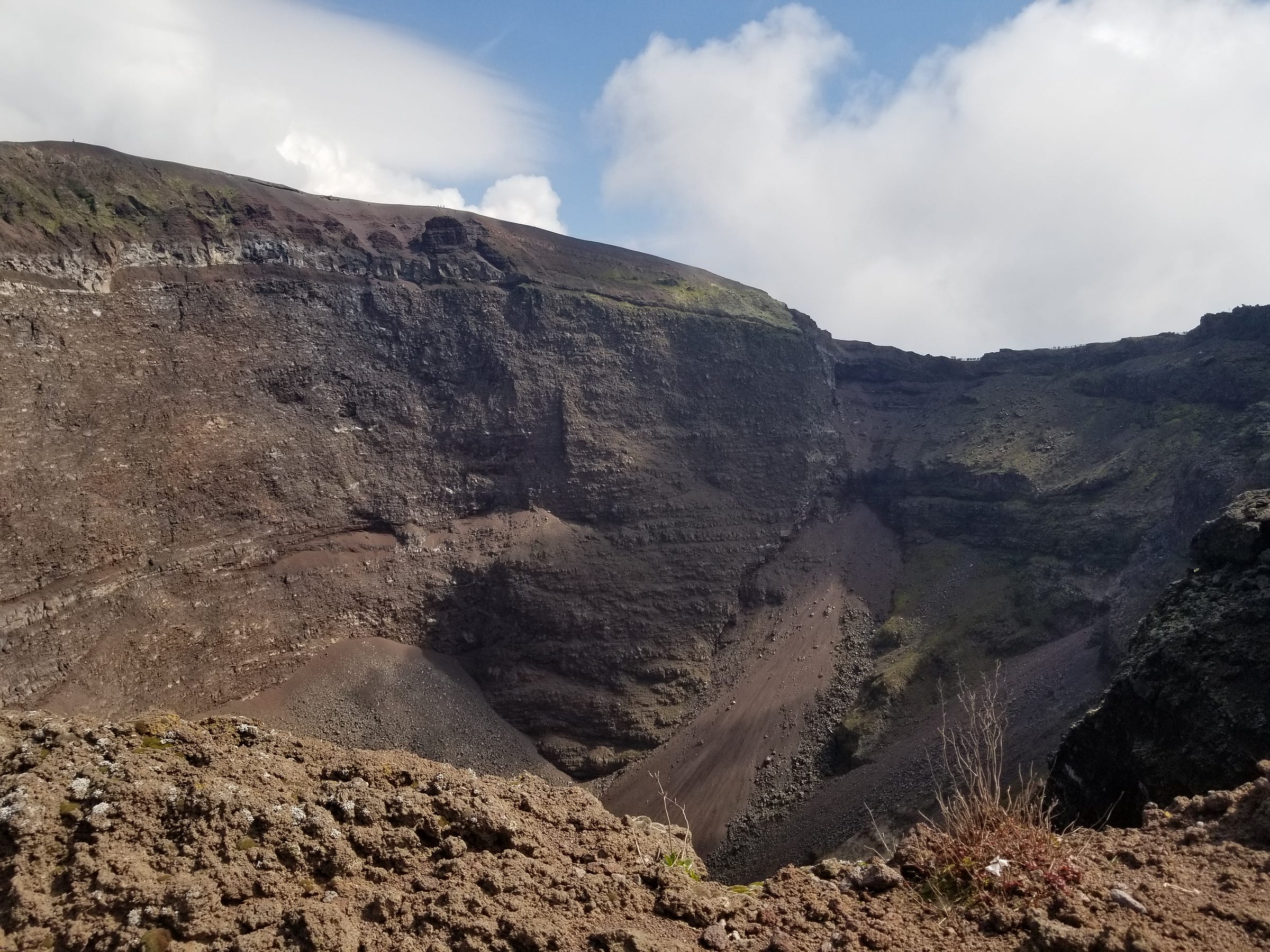
Once we passed through the entrance, there was an old man at the base who offered people walking sticks to aid their climb up Mount Vesuvius in exchange for a tip when it was time to return them. I decided to take a walking stick with me and was happy to have done so. Even though I’m in reasonably good physical shape, the climb was definitely a challenge for me, and so once I was able to return to base, I was very happy to give him some Euros for the loan! Despite the challenge of the climb to the summit and back, it was definitely worth the effort for me to see the crater of Mount Vesuvius as close as was permissible to gain an appreciation of the level of force required during the eruption to expel so much volcanic ash into the atmosphere and cause the enormous levels of destruction in its wake. It’s an experience and memory that I won’t soon forget.

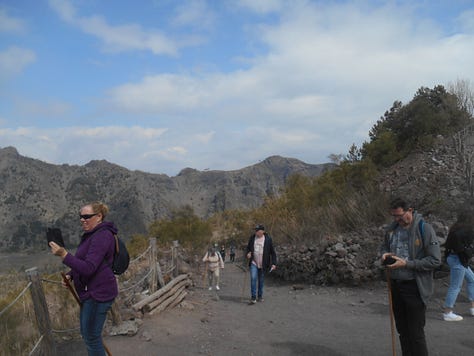
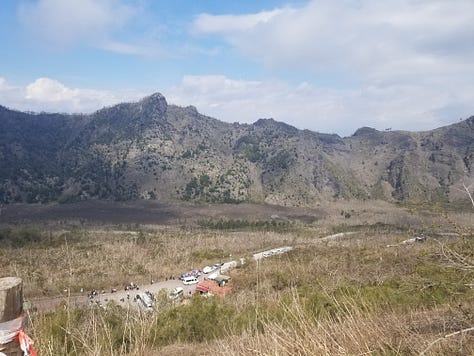
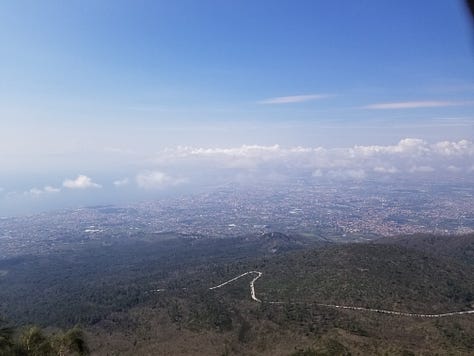
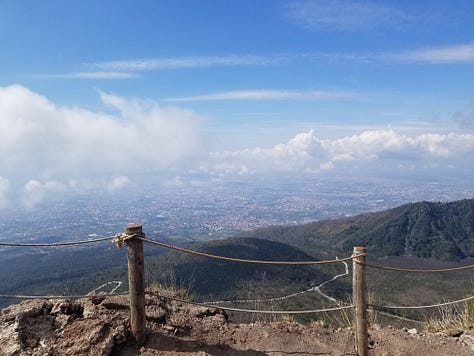
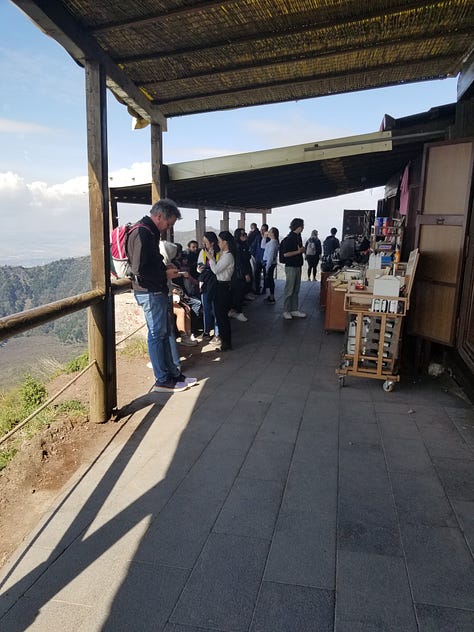

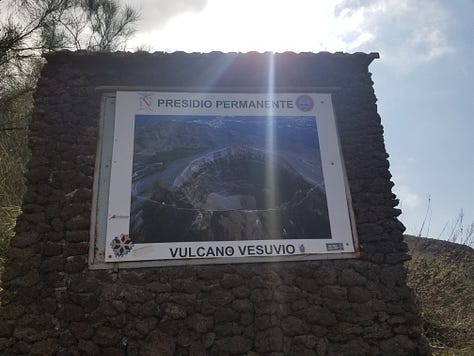
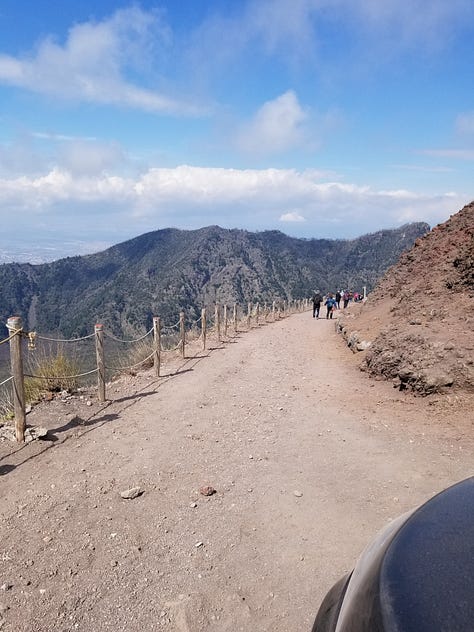
Once our group finally reassembled on the bus and was ready to go, we proceeded to our last stop of the day trip, that being the local winery and vineyard called Sorrentino Vesuvio, located at 6 Via Panoramica, Boscotrecase 80042 (https://www.sorrentinovini.com/), to learn about wine-making from the family-owned and operated business who hosted us. Carrying on the generational practice of wine-making with an emphasis on organic farming made possible by the nutrient-rich volcanic soil found in this vineyard, the company was founded by Paolo Sorrentino and his wife, Angela, who began their initial operation with a commitment to quality and tradition. Eventually, the successful business was passed down to their children, Giuseppe, Benny, and Maria Paola, who now have aspirations to expand their reach to international markets for their wine-making prowess.
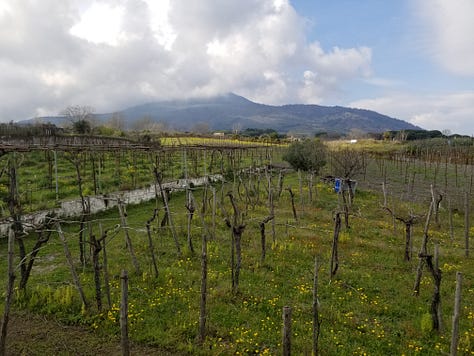
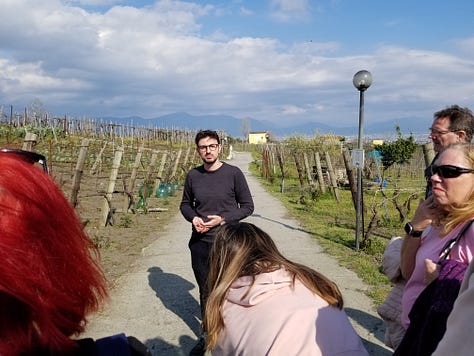

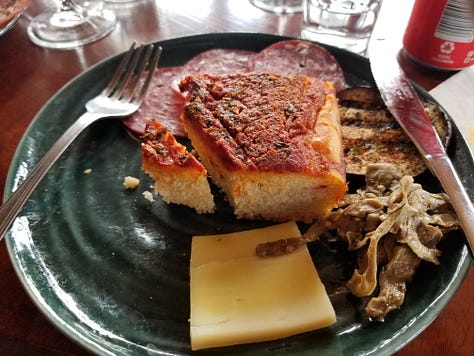

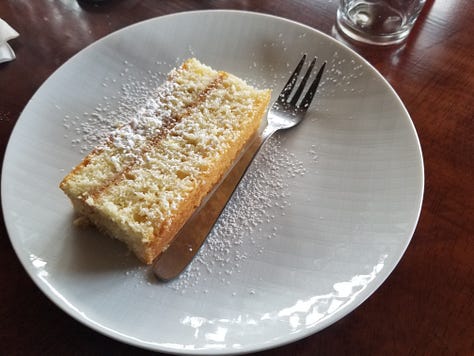
After being officially greeted by Giuseppe followed by a brief guided tour of the vineyard, we proceeded into the dining area where those who participated in the wine-tasting had a chance to sample both their red and white wines. Since I don’t drink alcohol, I cannot comment on what the taste experience was like, but from talking with people at my table, they all expressed enjoyment of the flavour and body of each wine they sampled, after which one of them approached Giuseppe about ordering a bottle or two of the wine available for sale onsite. Meanwhile, we were feted with a three-course meal with pasta and a lemon cake for dessert, which was well-proportioned and delicious. Sitting together to socialize and know each other briefly as a group was also an enjoyable experience for us to conclude a memorable day before we finally boarded our bus to return to Naples. Now ready to reach my hotel, I ended my trip to Pompeii and Mount Vesuvius very satisfied, indeed!
About World Tours Italy
For my visit to Pompeii and Mount Vesuvius, I came to very much value the professionalism of World Tours Italy that was responsible for the tour I undertook. Since returning home and reviewing the company website, I came to appreciate even more the immense variety of tour venues and price options that it offers its customers, ranging from relatively simple group tours of historical places for a small fee to much more elaborate and private tours that involve using boats and helicopters to gain special vantage points that are otherwise impossible to access. The idea of seeing the interior of Mount Vesuvius from a helicopter ride above already has me excited for a return visit!
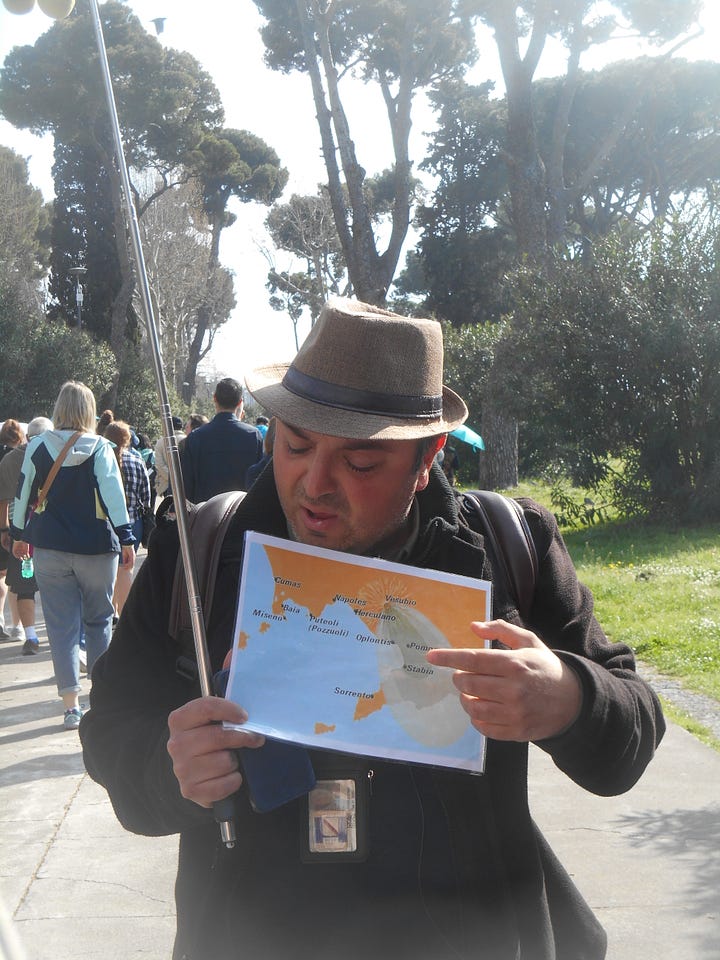
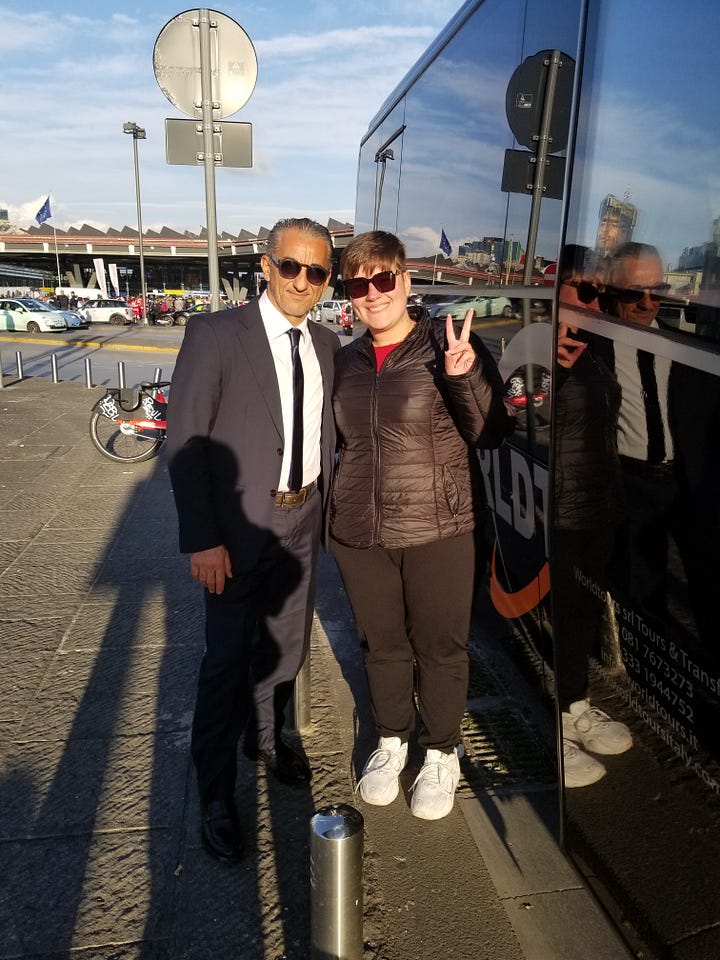
Besides Italian and English as its most popular language options, World Tours Italy provides tours for speakers of French, German, Spanish, Portuguese, Russian, Japanese, and Mandarin Chinese. Besides Pompeii and Mount Vesuvius, they also do guided tours of Herculaneum—another nearby Roman city that was also destroyed by the eruption, along with the modern cities of Naples, Positano, and Sorrento, plus the visually stunning Amalfi Coast.
Following my trip to Italy, I invited World Tours Italy executive, Amedeo Conte, and Alessandra to respond to some questions I had about their experiences as tourism experts and offer some insight into the type of services that they provide to their customers.
For instance, when asked about how they deal with medical emergencies that may arise, such as a slip-and-fall accident on Mount Vesuvius or something even more serious like a heart attack, they pointed out the fact that they have procedures in place to ensure that immediate medical attention is provided as quickly as possible. At the same time, under Italian law any direct intervention with resuscitation is only permissible for those having first aid certification called “Basic Life Support Defibrillation” (BLSD).
One of my past memorable experiences in Naples for all the wrong reasons was when I had to take a taxi from the train station to the University of Naples several years ago, in which I got to witness first-hand the chaotic traffic and dangerous road habits of some of its drivers. In contrast, I was most impressed with Bruno’s professionalism in navigating our tour group to reach Pompeii and Mount Vesuvius and return us back to Naples safely. When I asked Amedeo and Alessandra about how they manage to operate their tours on schedule and without the need to compromise on driving safely during the day, they made the point that because their drivers are from Naples and have deep familiarity with the driving habits within the city, they do their best to anticipate the chaos long before they can become immersed in the situation. Some of their biggest concerns come from the unpredictability of motorcyclists who dart through traffic rapidly wherever they see room to maneuver, and so drivers have to be particularly alert whenever they are around. As for situations when traffic disruptions such as road construction or major accidents are known in advance of a tour, this is to be expected and that World Tours Italy has procedures in place to make alterations in the normal routine, but always with a commitment to ensure that paying customers are given a satisfying tour experience despite any disruptions that may arise.
Given the fact that people from all over the world want to visit Italy, I was interested in knowing from World Tours Italy about how the company manages to professionally interact with customers coming from a wide range of cultural perspectives and social norms. The responses from Amedeo and Alessandra are that, while the tour guides have some advance training to handle the variety of behaviours that their customers may express during a tour, they said that direct experience is by far their best teacher. The accumulated wisdom derived from past interactions with customers helps the tour guides to seek out their own best practices over time to handle even the most adverse and unusual of cultural challenges during their tours.
Some of the more amusing and strange experiences that Alessandra and her colleagues had over the years involve tourists who seem to be completely unaware of where they are, such as asking if they can rent a car to drive to Capri island or if Italy has monkeys living in the woods! Another challenging experience they remember came from some tourists who asked if it was possible for the company to pack some food and wine for a customer who couldn’t attend because he was ill at the time. These type of strange and sometimes unreasonable requests from customers, while rare, make for memorable encounters that the tour guides are well-prepared to deal with as they arise.
As for the current and future aspirations of World Tours Italy, the company has a deep commitment to maintaining its focus on providing excellent tourism services in the region of Campania where Naples, Pompeii, and the Amalfi Coast are located. For its medium and long-term future, World Tours Italy is motivated to eventually become a “Destination Management Company” (DMC) to organize all the necessary logistics to satisfy vacation and business tourism opportunities in the region. A DMC is responsible for co-ordinating a one-stop organizational service for customers that includes scheduling for ground and air transportation, hotel reservations, pre-scheduled excursions, opportunities to attend special events, and other related services to satisfy tourists’ needs. Based on my very positive experience with the tour of Pompeii and Mount Vesuvius, I think that World Tours Italy has a very bright future ahead!
Concluding Remarks
Capturing a snapshot of the Roman Empire’s legacy across different lands and times in history from two recent trips to Europe easily makes for strong memories to carry into the future. I cannot help but be impressed with what I saw and experienced on multiple levels. Of course, lots of questions remain about why the Roman Empire, after several centuries of rule in Europe and parts of Africa and the Middle East, finally came undone to leave behind only its fossilized remains for future generations of people to wonder and learn about. What is there to be said about the present-day and future understandings of the Roman Empire, based solely on the archeological legacy left behind by the Romans? Only time will tell, but for now I think the multitude of questions posed by every artifact unearthed deserves answers.
For those of us with a deep interest in Roman Empire history and its lessons to teach about where we are as a global civilization today, the allure of learning and seeing more about what is left behind remains ever present, either as a tourist or as a serious scholar. As far as I’m concerned, the interest can only grow more in the course of time and will remain a topic of major exploration in the years to come.
Author’s Note: This article was first written in June 2024 and submitted to Luxe Beat magazine for future publication.




Hi. Please feel free to comment on this article anytime if you like what I've written or have anything constructive to add. Also, please take a moment to check out my "About" page and become a free subscriber to "Scientist World Traveller" if you haven't already done so. Thank you.